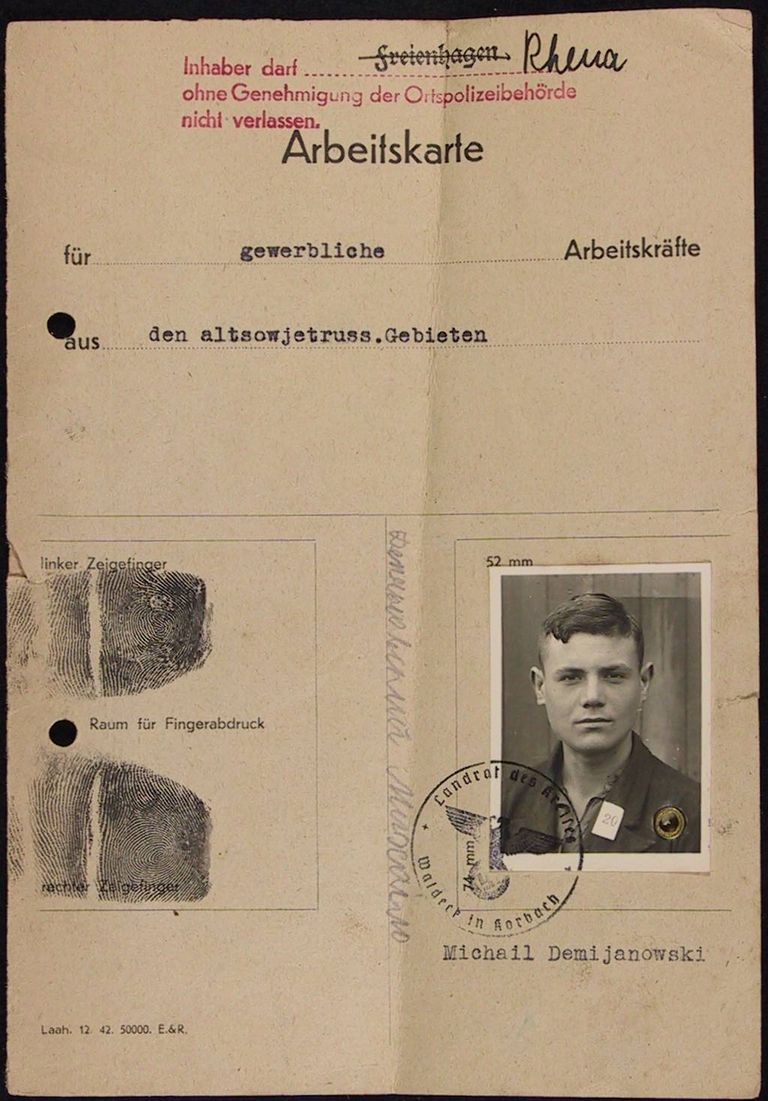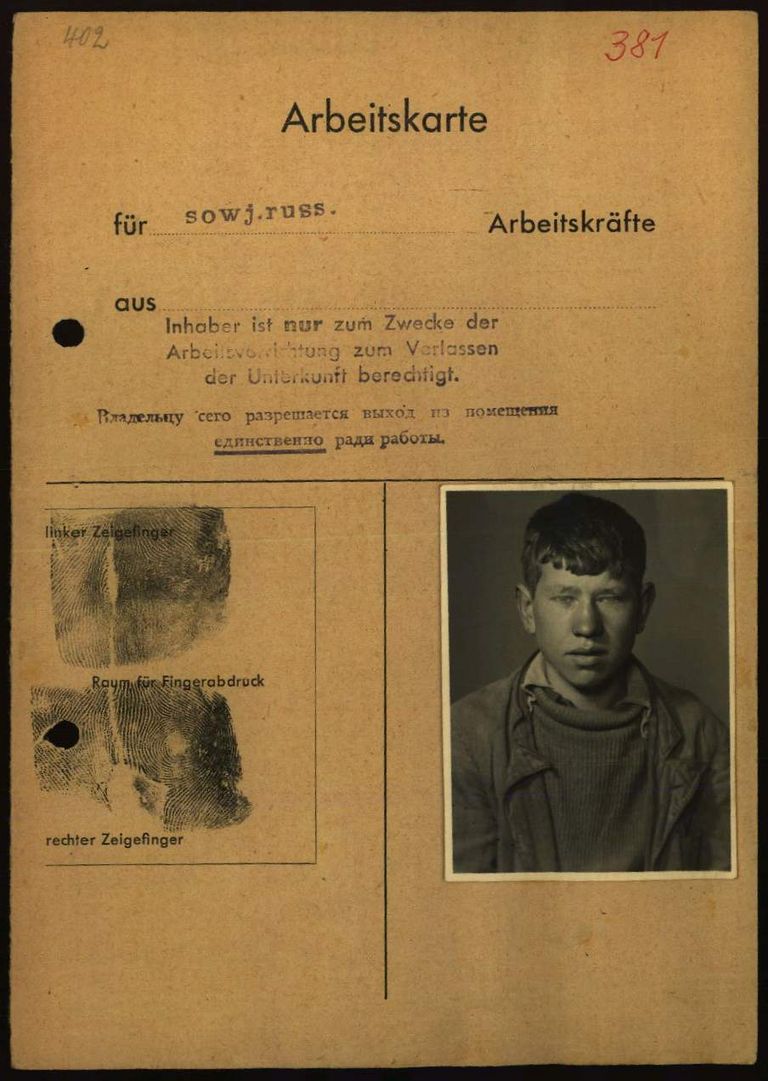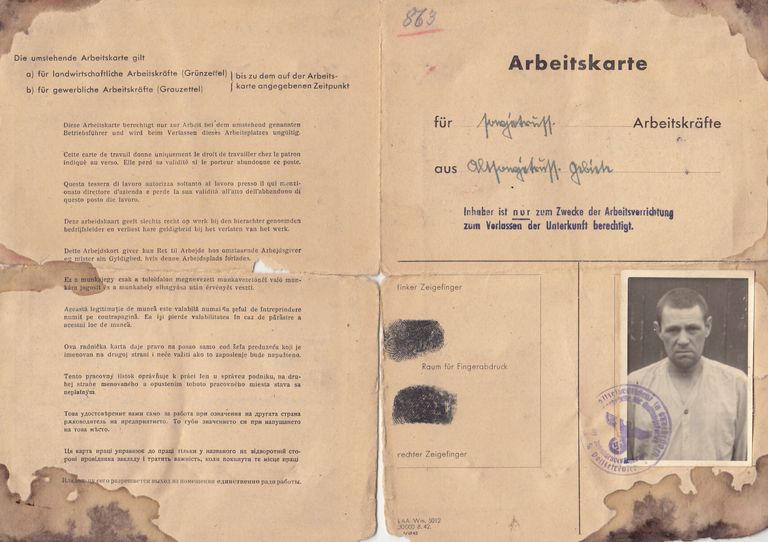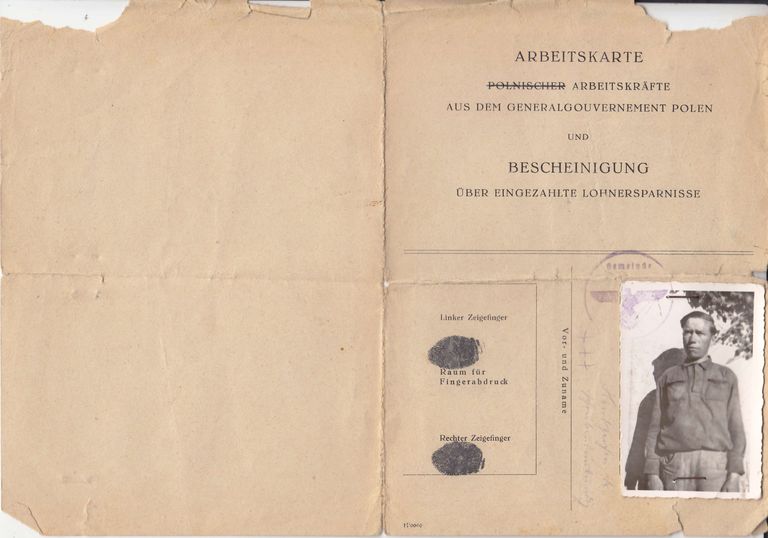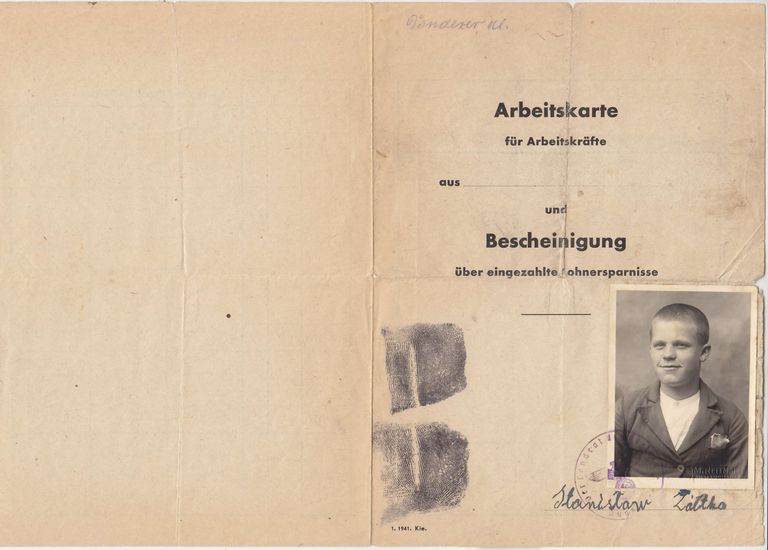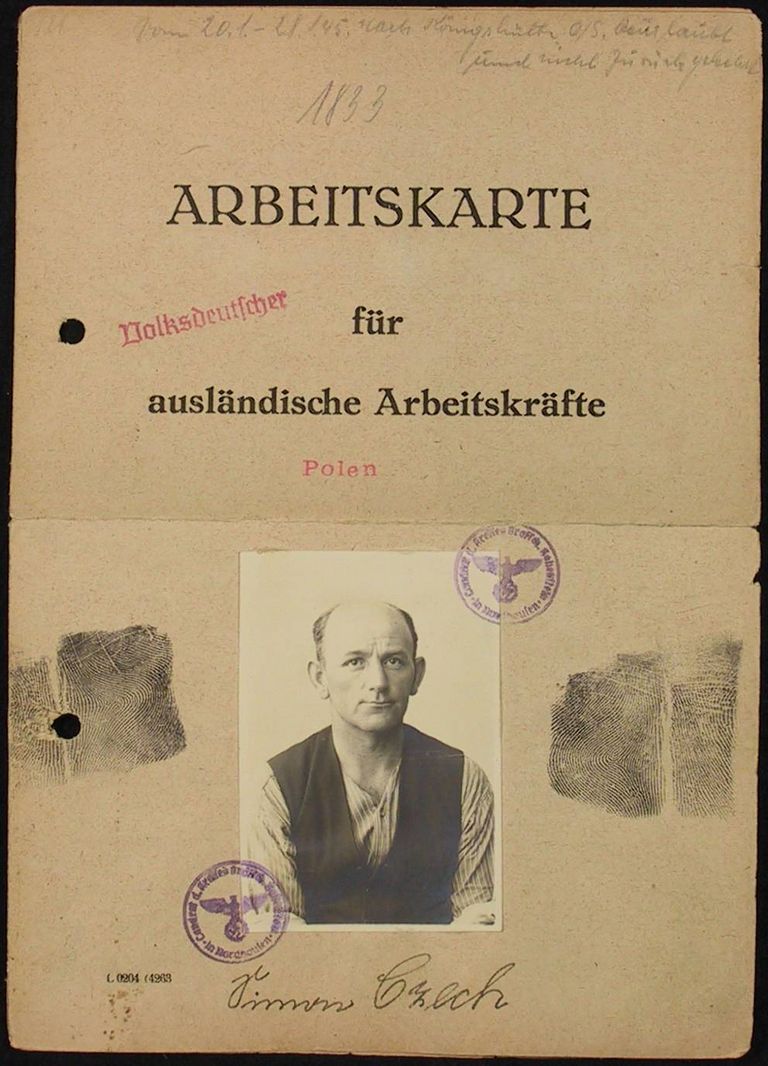Page of
Page/
- Reference
- Intro


Civilian forced laborers were given labor cards (Arbeitskarten) so their identity could be established when the police made checks. Including a photo and fingerprints, labor cards functioned as identity cards, and civilian forced laborers were required to carry them on their person at all times.
Labor cards came in many different variations, one of which was a general card with the inscription für ausländische Arbeitskräfte (for foreign workers). The cards were also adapted for the groups that were deported to the German Reich for forced labor: There were special labor cards for Polish civilian laborers, and later also for Soviet civilian laborers. Labor cards were only valid if they had a work permit document pasted inside them.
Civilian forced laborers were given labor cards (Arbeitskarten) so their identity could be established when the police made checks. Including a photo and fingerprints, labor cards functioned as identity cards, and civilian forced laborers were required to carry them on their person at all times.
Labor cards came in many different variations, one of which was a general card with the inscription für ausländische Arbeitskräfte (for foreign workers). The cards were also adapted for the groups that were deported to the German Reich for forced labor: There were special labor cards for Polish civilian laborers, and later also for Soviet civilian laborers. Labor cards were only valid if they had a work permit document pasted inside them.
Questions and answers
-
Where was the document used and who created it?
Preprinted labor cards were generally stored at the employment offices. Employment office staff pasted a work permit document into a labor card when it was first issued. This permit showed details of the company where the person was required to perform forced labor. They then sent the labor cards to the police department that was responsible for the particular area. Civilian forced laborers were required to report there immediately on their arrival in the local area or city. Before receiving their labor cards from police department staff, they were photographed, and their fingerprints were taken. At the same time, cards were also created for the card file of the German foreigner police and the Reich Main Security Office (Reichssicherheitshauptamt, RSHA).
There was also the option for employment office and police department staff to register foreign civilian laborers and issue labor cards upon their arrival at the transit camps. This was often the case with civilian forced laborers who were deported to the German Reich from Poland and the Soviet Union on large collective transports. From February 1944, over 40 transit camps in the German Reich had their own branches of the district police authorities.
- When was the document used?
The first regulations originate from a decree on labor cards for foreign workers from March 1940. All Poles who had worked in the German Reich since September 1, 1939, i.e. since the beginning of the war, or who had been deported there for forced labor, were to be given a labor card retrospectively. As the war progressed and the use of forced laborers increased, the preprinted labor cards were adapted time and time again. Labor cards remained the most important identification document for civilian forced laborers until the end of the war.
- What was the document used for?
Civilian forced laborers needed a labor card to prove their identity outside their communal accommodation and their places of work. Different rules on where they were allowed to be and when applied depending on their nationality and ethnicity. Labor cards allowed the police to quickly determine whether a forced laborer was violating one of these regulations. Polish civilian laborers, for example, were not allowed to leave the town or city where they were required to perform forced labor. They were also forbidden from going out at night, and could only use public transport or bicycles if they had permission from the police. Until December 1942, Soviet civilian laborers were only allowed to be in their communal accommodation, which usually consisted of wooden barracks, or at their place of work.
For this reason, it was important for the police that labor cards, and especially the work permit documents they contained, were always up to date. If an employment office deployed civilian forced laborers to a new place of work, they issued a new work permit document which was pasted into the labor card over the old one, which was now invalid. Labor cards of civilian forced laborers who died or were sent back to their native countries were returned to the relevant employment offices.
- How common is the document?
In theory, all civilian forced laborers in the German Reich had a labor card. So there must have been millions of labor cards, but only a small number have survived. This is mainly because the civilian forced laborers carried their labor cards with them. Consequently, some of the liberated civilian laborers took their labor cards with them when they went home to their native countries. Others left them behind, or deliberately destroyed them, so as not to be reminded of their time in forced labor, or out of fear of being accused of collaboration if they were interrogated on their return to their native countries.
It is impossible to say exactly how many labor cards are held in the Arolsen Archives. Some labor cards were among the personal effects that came to Arolsen from the Dachau and Neuengamme concentration camps. Civilian forced laborers who were imprisoned in concentration camps were required to hand in their labor cards together with their other possessions when they arrived at the camps. However, most labor cards only came to the International Tracing Service (ITS), the predecessor institution of the Arolsen Archives, as scanned documents or microfilms from company, city, and local authority archives from the 1980s onwards. The ITS staff did not store the labor cards in a separate card file, but filed them together with other documents in alphabetical order in the War Time Card File (Collection 2.2.2.1) which contains 4.2 million documents. But in the near future, modern computer technology will find the answer: clustering techniques will make it possible to identify labor cards, as well as other documents, and to virtually collate cards of the same type. However, the labor cards of all civilian forced laborers have by no means survived.
- What should be considered when working with the document?
Today, the term Arbeitskarte (labor card) is used incorrectly for a large number of different cards. Work permit documents, which were pasted into labor cards, are often referred to as labor cards, for example. Sometimes, identity cards that were issued by companies for their workers are also called labor cards.
If you have any additional information about this document, please send your feedback to eguide@arolsen-archives.org. The document descriptions in the e-Guide are updated regularly – and the best way for us to do this is by incorporating the knowledge you share with us.
Variations
Help for documents
About the scan of this document <br> Markings on scan <br> Questions and answers about the document <br> More sample cards <br> Variants of the document

